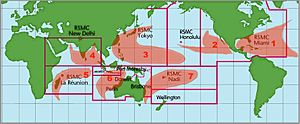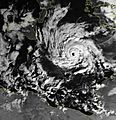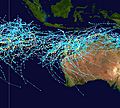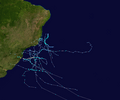Tropical cyclone basins facts for kids
Imagine the Earth's big oceans! Tropical cyclones, which are like giant spinning storms, don't just pop up anywhere. They usually form in specific parts of the world's oceans. These special areas are called tropical cyclone basins. There are seven main basins where these powerful storms are born and grow.
Contents
What are Tropical Cyclone Basins?
Tropical cyclone basins are like nurseries for big ocean storms. These are areas in the world's oceans where conditions are just right for tropical cyclones to form. These conditions include warm ocean water, moist air, and winds that help the storm spin.
Scientists and weather experts divide the world into these basins. This helps them track and study the storms. It also makes it easier to warn people living near the coasts when a storm is heading their way.
The Seven Main Basins
There are seven main areas where tropical cyclones usually form. Each basin has its own busy season for storms.
North Atlantic Ocean
This basin covers the Atlantic Ocean north of the equator. It includes the Caribbean Sea and the Gulf of Mexico. Storms here are called hurricanes. The hurricane season usually runs from June 1 to November 30. This area is known for powerful storms that can affect the United States, Mexico, and Caribbean islands.
Eastern Pacific Ocean
This basin is in the Pacific Ocean off the coast of Mexico and Central America. Storms here are also called hurricanes. They often move west, away from land. The season here is also from May 15 to November 30.
Western Pacific Ocean
This is the busiest tropical cyclone basin in the world! It's located west of the International Date Line in the Pacific Ocean. Storms here are called typhoons. They can affect many countries in Asia, like the Philippines, Japan, and China. This basin sees storms all year round, but the peak season is from May to November.
Southwestern Pacific Ocean
This basin is south of the equator, covering parts of the Pacific Ocean near Australia and the Pacific Islands. Storms here are called tropical cyclones. The season usually runs from November to April. These storms can bring heavy rain and strong winds to islands like Fiji and Vanuatu.
Southwestern Indian Ocean
This basin is in the Indian Ocean off the coast of Africa and Madagascar. Storms here are called tropical cyclones. The season is usually from November to April. These storms can affect countries like Madagascar, Mozambique, and Mauritius.
Southeastern Indian Ocean
This basin is located off the coast of Australia, in the southeastern part of the Indian Ocean. Storms here are also called tropical cyclones. The season is similar to the southwestern Indian Ocean, from November to April. These storms often affect the western and northern parts of Australia.
Northern Indian Ocean
This basin includes the Bay of Bengal and the Arabian Sea. Storms here are called cyclones. This basin has two main storm seasons. One is before the monsoon rains (April to June) and another is after (September to December). Countries like India, Bangladesh, and Myanmar are often affected by these storms.
Images for kids
-
Tracks of all tropical cyclones in the northern Atlantic Ocean between 1980 and 2005
-
Tracks of all tropical cyclones in the northern Pacific Ocean east of the International Date Line between 1980 and 2005; the vertical line through the center separates the Central Pacific basin (under the Central Pacific Hurricane Center's watch) from the Northeastern Pacific basin (under the National Hurricane Center's area of responsibility).
-
Tracks of all tropical cyclones in the northern Indian Ocean between 1980 and 2005
-
Tracks of all tropical cyclones in the southwestern Indian Ocean between 1980 and 2005
-
Tracks of all tropical cyclones in the southeastern Indian Ocean between 1980 and 2005
-
Tracks of all tropical cyclones in the southwestern Pacific Ocean between 1980 and 2005










